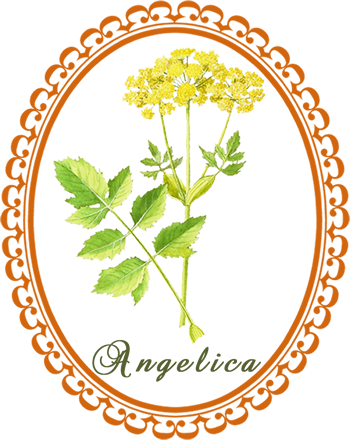
Angelica: should always be remembered in epidemics, as it is said to resist poisons by defending and comforting the blood, heart and spirits ...
Common Names: Angelica, Archangel, Masterwort
Botanical Name: Angelica archangelica
Family: Umbelliferae / Apiaceae
Plant Type: Three-year hardy biennial
Parts Used: The entire plant
Flowering: July
Angelica archangelica is native to, and grows wild in Finland, Sweden, Norway, Denmark, Greenland, the Faroe Islands and Iceland, mostly in the northern parts of the countries.
Description: Angelica is a tall, stout very ornamental and aromatic plant with large white flowers, growing to a height of 4 to 6 feet or more. It is found in rich thickets, bottomlands, moist cool woodlands, stream banks and shady roadsides. It has a smooth, dark purple, hollow stem 1 to 2 inches round. The leaves are dark green, divided into three parts, each of which is again divided into three serrated leaflets, sometimes lobed. The lower leaves are larger sometimes 2 feet wide. Angelica leaves have flattened, inward curved, stalks with clasping bases or sheathing to form an elongated bowl which holds water. The root is branched, from 3 to 6 inches long, thick and fleshy with several small rootlets. Flowers are small and numerous, yellowish or greenish-white and grouped into large, compound umbels. The flowers bloom in July and are succeeded by pale yellow, oblong fruits, 1/6 to a 1/4 inch in length when ripe produced in somewhat rounds heads, which sometimes are 8 to 10 inches in diameter.
Cultivation: Moist well-drained soil in part shade. Angelica like a pH of 6.3 and is hardy to zone 3.
Harvesting: Harvest leaves before the plant flowers to use fresh, or dry. Gather the seeds when ripe in early autumn, then dry. Dig up root in autumn of the plant's first year, then leave to dry before using.
Culinary Uses: Angelica has a sweet licorice flavor. Use the leaves raw in soups, salads, fruit dishes, and as a garnish. Add dried leaves to desserts. The roots have a stronger flavor; add to cookies, cakes, and breads. Candy the stem for a special treat, or steam it and serve like asparagus. The addition of Angelica to pies and sauces lessens the need for sweetener.
Angelica Magick
Exorcism. Healing. Visions. Protection.
Gender: Masculine
Planet: Sun
Element: Fire
Diety: Venus
Angelica is effective against negative thoughts and misfortune.
Sprinkle the four corners of the house with Angelica to ward off evil.
Grow Angelica around your property to repel negativity and invite angels and fairies.
Add Angelica tea to your bath to remove curses, hexes and any spells that may have been made against you.
Herbal Healing with Angelica
Medicinal Actions: Analgesic, antibacterial, antifungal, anti-inflammatory, antirheumatic, antiseptic, antispasmodic, antiviral, aperitive, aphrodisiac, astringent, carminative, cephalic, cholagogue, depurative, diaphoretic, digestive, diuretic, emmenagogue, estrogenic, expectorant, febrifuge, healing (skin), hepatic, nervine, revitalizing, stimulant (uterine; nerves), stomachic, sudorific, tonic, vulnerary
Medicinal Uses: Angelica improves digestion, soothes the intestines and relieves nausea. It stimulates the appetite, making it useful in the treatment of anorexia nervosa. It relieves aches and pains caused by rheumatic inflammations and menstrual discomforts. It is a urinary antiseptic in cases of cystitis. Angelica is a good expectorant for coughs, bronchitis and pleurisy, especially when accompanied by fever, colds or influenza. It improves mental clarity and alertness, encourages dreaming and is helpful for meditation.
Contraindications:
- Avoid angelica during pregnancy or breast-feeding
- Avoid angelica if you are taking Coumadin (blood thinner)
- Use angelica with caution if you have diabetes (angelica has a tendency to increase the sugar in the urine)
- Avoid direct sun exposure when using angelica
- If you are allergic to angelica, it may cause symptoms such as: problems breathing or a tightness in the chest or throat, chest pain, hives, rash, swollen or itchy skin
Body Care with Angelica
- To ease muscles, soak in a bath to which you have added 500 ml (2 cups) double-strength angelica leaf infusion
- For a liver detox, drink 1/2 cup angelica decoction three times daily for two to three weeks
Infusion: Add 2 teaspoons dried or 4 teaspoons fresh angelica leaves in 1 cup just-boiled water.
Decoction: 30 g (1 oz) dried or 60g (2 oz) fresh angelica root in 750 ml (3 cups) water.
Source: The Essential Herbs Handbook by Leslie Bremness
Healing Combinations with Angelica
- For bronchial problems, combine with coltsfoot (Tussilago) and white horehound (Marrubium vulgare)
- For indigestion, flatulence and loss of appetite, combine with Chamomile
- For musculo-skeletal problems, combine with black cohosh (Actaea racemosa), willow bark (Salix alba) and bogbean (Menyanthes trifoliata).
Safety First: Water Hemlock looks and grows in the wild much like angelica, but is very poisonous! Extreme caution should be taken when harvesting wild angelica - it is best to grow it in your own garden (if possible) or purchase the product from a retailer.
If you appreciate the information provided,
please help keep this website running. Blessings!
© 2008-2025 aromaworx.ca. All rights reserved.

